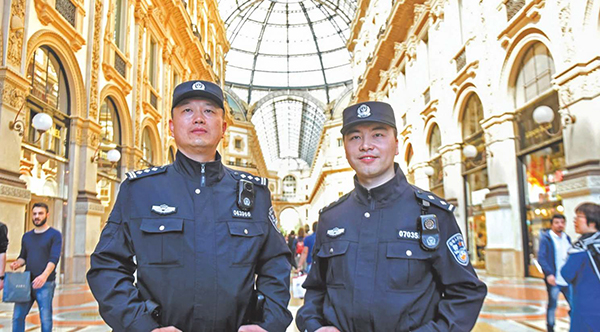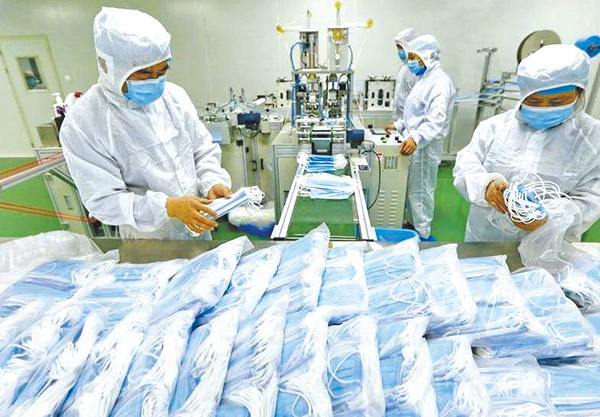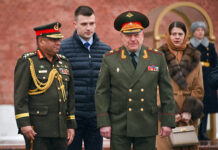
The Chinese government spent weeks denying and downplaying the severity of its growing coronavirus outbreak that eventually spread to the rest of the world. But it did not let the crisis go to waste. Instead, it took advantage of the chaos to pursue its long-term foreign policy goals more aggressively and continues to do so.
China has capitalized on the world’s distraction to claim sovereignty over disputed islands in the South China Sea, intimidate Taiwan and assert more authority over Hong Kong in an attempt to quash the pro-democracy movement there.
It has taken advantage of vulnerable countries dependent on it for medical supplies, investments in the Belt & Road Initiative activities and those suffering from the adverse economic impact of the virus.
After the US suspended funding to the World Health Organization (WHO) the Chinese government pledged millions of dollars in additional support for the organization, giving China even more influence in the global health agency and allowing the country to portray itself as the new champion of multilateralism.
The incompetence of many countries around the world in preparing for and responding to COVID-19 provided China with relative gains. In many quarters, China’s initial failures have been overshadowed by the challenges faced in Europe and the incompetence of the Trump administration.
China believes that it has faced humiliations over the past century and the time is right for China to take revenge with ‘America and the West in decline’. The conflict has intensified with the spread of the COVID-19 pandemic to the rest of the world. Beijing feels confident that it has handled the outbreak better than Western democracies.
Hong Kong
Xi used the distraction of the coronavirus pandemic to exert more authority in Hong Kong and crack down on the pro-democracy movement there. On April 18, more than a dozen pro-democracy activists and lawmakers were arrested in Hong Kong, marking the largest single-day roundup in years.
In mid-April, the Hong Kong and Macau Affairs Office, the Chinese state agency that closely oversees Hong Kong, criticized some of the city’s lawmakers for filibustering debates, which it said has led to a backlog of legislation.
Taken together, experts say Beijing is using the coronavirus as a cover to cement its authoritarian rule over Hong Kong and stamp out the pro-democracy movement once and for all.
South China Sea
Beijing has long laid claim to disputed islands in the South China Sea. To stake its claim, Chinese naval vessels have pushed other claimants, like the Philippines and Vietnam, out of the area so it can have full control of the islands and the oil and natural gas resources around them.
That practice has not stopped during the pandemic and amounts to sending a message to other countries involved in the South China Sea that China will not back down under any circumstances. Earlier this month, for example, a Chinese ship sank a Vietnamese fishing boat in the South China Sea and claimed other regional islands for itself.
Taiwan
China’s military continues to place pressure on Taiwan, including regular flights by fighter jets near Taiwanese airspace and sending flotillas close to the island. The US clearly sees an extra layer of threat in these times. US warships, which usually sail by Taiwan about once a month, have been in the area at least twice in April.
Africa
China has flexed its muscles on other continents, especially in Africa. Many African governments struggling to respond to the coronavirus asked for debt relief so they could invest more in health care, sanitation, food, and social programs to keep millions of people safe during the pandemic.
Chinese leaders asked officials from Zambia, to provide collateral, in their case Zambian copper-mining assets, sending a signal that it was not for debt forgiveness.
China foreign policy is based on give and take. It expects return on investments made even if it means acting the bully in the time of need and ignoring the racism against Africans back in China during the coronavirus crisis, when many Africans were barred from hotels, restaurants and shops.
Domination of International Bodies
Over the past several years, Beijing has systematically positioned Chinese nationals at the head of a wide range of U.N. agencies. Since 2019, the U.N. Food and Agriculture Agency has been led by Qu Dongyu, formerly China’s vice minister of agriculture. This followed the 2018 reinstatement of Zhao Houlin, who began his career in China’s Ministry of Posts and Telecommunications, for a second four-year term as the secretary-general of the International Telecommunication Union, a crucial body that sets technical standards for communications networks; Zhao has used his position to advance Huawei’s standing as a vendor of 5G telecommunications equipment worldwide. The previous year, U.N. Secretary-General António Guterres appointed Liu Zhenmin, formerly China’s vice minister for foreign affairs, to a key position in the U.N.’s Department of Economic and Social Affairs – a body tasked with advancing the U.N.’s hallmark program to promote development, combat climate change and reduce inequality.
In part, this dominance of Chinese nationals in key U.N. agencies reflects Beijing’s savvy diplomatic maneuvering as a rising power, and its position as the world’s second-largest economy. But it’s also possible because of a void left by the United States, which under Trump has repudiated its previous leadership role in international organizations.
And as Chinese technology proliferates across the reaches of the organization, China has joined hands with Russia to institutionalize international norms around surveillance and censorship, including through the passage of a joint U.N. cybercrime resolution in November 2019 that equips authoritarian governments with broad-based authority to repress and censor political dissent online.
In March, just weeks before Trump began talking about curbing funding to the agency, China announced a $20 million donation to the WHO to fight Covid-19.
Diplomatic Offensive
Cheng Jingye, China’s ambassador to Australia, questioned whether Australia was “the best place to send” Chinese students for education, or whether Chinese consumers would want to buy Australian wine and beef, after Prime Minister Scott Morrison called for an independent review of the spread of the virus.
Vice-foreign minister Le Yucheng accused the U.S. of “political manipulation to a level beyond anyone’s imagination” in response to White House pressure over the virus.
In France, Lu Shaye, who previously served as ambassador to Canada, released a series of attacks on the “malevolence” of the French media, calling them lapdogs of the U.S.
In the Netherlands, the Chinese embassy called De Volkskrant newspaper “full of prejudice, discrimination and malice.”
Policy experts in China have explained Beijing aggressiveness was a result of Donald Trump administration manipulating the emotions of other countries to join the U.S. in strategically constraining China.
Pakistan
China exerted quiet pressure on Islamabad to flow against the global current and not blame China. It also prevailed upon Pakistan not to evacuate its nationals from Wuhan even when India offered to air lift when it evacuated its own nationals from China.
In fact, in March, just a week after the WHO declared the coronavirus outbreak a pandemic, Pakistani President Arif Alvi met with Chinese President Xi Jinping in Beijing. Alvi expressed Pakistan’s solidarity at a time when China’s global reputation was at a low point. A week later, the favour was returned when a planeload of Chinese medical face masks landed in Karachi.
In Pakistan’s media, there was a clear push to deflect blame for the pandemic away from China and to trumpet the fact that initial infections came by way of Pakistani pilgrims returning from Iran rather than from Chinese workers and goods or Pakistanis studying in China. Pakistan’s news outlets emphasized the generosity of Chinese aid, including medical supplies, technical experts and cash.
Expectations for China are clearly higher among Pakistan’s leaders and the public at large. Pakistan has appealed to Beijing directly for relief, both for debt repayment and for power purchases. Whether Beijing is actually ready or willing to deliver a truly generous dose of aid that would enable Pakistanis to better weather the storm is a moot question.
Southeast Asia
China is the most influential regional economic and politically strategic power, but large majorities worry about this influence.
China-Southeast Asia relations are unlikely to be significantly damaged by the pandemic. Southeast Asian governments have avoided pointing fingers and instead shown solidarity with China in fighting the virus. Some, like the Cambodian government, have bent over backward; Prime Minister Hun Sen visited China during the peak of the outbreak and declared that “the disease of Cambodian citizens is not a disease caused by the virus ‘corona’ but a disease of fear.” The Chinese government thanked Southeast Asian countries and reciprocated with aid. Chinese narratives portray Southeast Asia as standing with China.
On 1 February, Singapore closed its borders to all travelers from China, the first country in Southeast Asia to do so. The Singaporean government took pains to avoid offending the Chinese government with this decision. On 2 February prime minister Lee Hsien Loong said he knew “that China is doing all it can to contain the spread of the virus. … Even though the virus started in Wuhan, it doesn’t respect nationality or race. It does not check your passport before it goes into your body.”
The Chinese embassy and Chinese foundations and firms have made huge donations of medical supplies not only to Malaysian hospitals and government agencies but also to various social and cultural groups of different ethnic backgrounds. The diplomatic mileage, however, was undermined by a Chinese survey ship Haiyang Dizhi-8 spotted tagging a Malaysian exploration vessel off the coasts of Brunei and eastern Malaysia. China’s activities in the South China Sea left the impression that Beijing was taking advantage of the COVID-19 situation to advance its territorial interests in the disputed waters.
China assisted Indonesia with essential medical supplies flown back from Shanghai by the Indonesian Air Force. Meanwhile, a new ASEAN-China COVID-19 Response Fund has been established in collaboration with the ASEAN Plus Three (APT) states (China, Japan, and South Korea). Beijing has also committed to providing financial and material support through the more established ASEAN-China Cooperation and APT Cooperation Funds.
Affect on Belt and Road Initiative
The nature, pace and scope of Belt and Road Initiative (BRI) has also been affected, and will continue to do so in the longer-term. Despite the downturn in manufacturing and supply chain activity, the pace of digital BRI activity has ramped up..
BRI has investments across more than 100 countries and multiple sectors per country (power, railways, ports, roads and industrial parks).
All previous forecasts have been altered in the wake of COVID-19 and ongoing commercial tensions between China and the US.
Chinese state companies have turned their focus to investments in ports, power and industrial parks across Southeast Asia.
ICT companies and e-commerce platforms are seeing new opportunities for full digital value-chain under digital BRI activity opening up new avenues for companies such as Alibaba’s DingTalk, Tencent’s WeChat Work and Huawei’s WeLink to bid for market share outside of China, especially in the BRI region.
Chinese state banks are facing greater greater capital constraints, and non-performing loans are likely to rise at home, owing to COVID-19 related financial weakness. With focus turning towards the most commercially profitable supply chain related investments, BRI projects will increasingly focus on profitable supply chain related opportunities in Southeast Asia where the private sector and private capital play a greater role.
Whatever the lasting impact of COVID-19 on the economy, BRI will remain a priority for China. The financial challenges may, though, divert official attention and resources away from BRI over the next year or two.
Health Silk Road
Instead of being the irresponsible government whose failures unleashed a deadly pandemic on the world, China tried to look like the world’s savior, graciously providing critical supplies to countries in need.
China is advancing its Health Silk Road to assert global leadership, conducting diplomatic overtures to leaders across Europe, Latin America and Africa as it deploys medical equipment and aid to hard-hit countries such as Italy.
China sent medical equipment and physicians to countries in Europe that were struggling to deal with coronavirus outbreaks. It has also sent supplies and resources to Serbia, the Netherlands, and Spain. In some cases, China’s benevolence backfired. Some of the test-kits Beijing gave to European nations did not work. Spanish scientists found that testing devices from China correctly identify a positive case only 30 per cent of the time.
China’s aim is to expand its economic reach in Europe and to weaken US alliances in the region. Italy was the first major European country to sign on to China’s Belt and Road Initiative. But some countries have got fed up with Beijing’s pressure tactics and posturing.
Some 200 Italian business are now controlled by Chinese owners (not including the ones owned by Chinese living in Italy), while China’s central bank holds stakes in several Italian blue chips like Fiat, Telecom Italia, Generali and Eni, among others.
Comments
Amid the ongoing pandemic, we can expect regional international relations to be increasingly contentious over the distribution of power, the strength of bilateral relationships, choices of rules and institutions, and Chinese versus U.S. narratives of blame and culpability.
Few believe in China’s altruistic moves. Most see them as opportunistic. The US left a leadership void, and China quickly stepped in to fill it. With just a small donation, Beijing gets to look like a staunch advocate of global cooperation and a responsible partner in the public health response to the coronavirus, in contrast to the US.
Experts say this is all part of Xi’s broader strategy to dislodge America as the world’s sole superpower and expand China’s reach around the world. In other words, he’s merely exploiting the coronavirus crisis to achieve his aims even faster.
China’s aggressive attempts to exploit the pandemic for its own benefit have made it harder for governments – especially the United States – to trust and work with the country.
It is far from certain who will win the international diplomatic fight sparked by the crisis-if anyone. But if China comes out on top, it will be a public diplomacy battle that the world’s leading liberal democracies have lost, not one that China has won. The beneficiary of this race to the bottom may be the only superpower left standing: China.
===================
In early May 2017, Chinese police officers in their national uniforms started patrolling streets in Milan and Rome alongside Italian cops.
Masks and other items do not need Chinese regulatory approval before export. Many Chinese testing kits exported were found unfit.
==============
Sino-Indian Relations in Covid Times
Indians have been skeptical of China’s role in handling the coronavirus pandemic. Indian rhetoric has been measured, due primarily to its dependence on China to procure medical supplies and its desire to keep the relationship stable. But India has been concerned with the economic fallout. Many sectors in India, like pharmaceutical, are primarily dependent on China for industrial inputs and ingredients.
India has also been concerned with the pace of Chinese investment in India and Chinese entities’ taking taking advantage of the crisis to acquire vulnerable Indian companies, increase its influence in India’s neighborhood, and exerting a more assertive regional leadership role.
To circumvent hostile Chinese takeovers the government has announced restrictions on foreign direct investment from countries that share a land boundary with India-a move clearly directed against China.

In a bid to keep Chinese influence at bay, India was also active with diplomatic outreach, economic aid, technical assistance, and the provision of medical supplies to Maldives, Mauritius, Seychelles, Sri Lanka, Bangladesh and Nepal.
India also actively engaged other countries in their fight with COVID-19. As the largest producer of anti-malarial drug hydroxychloroquine, initially it banned exports of the drug on March 25 and further tightened rules on April 4 to bar exports from special economic zones (SEZs). Leter, it approved the supply of the hydroxychloroquine and paracetamol, either as commercial sales or as grants, to 55 countries including US, Brazil, Israel and UAE.
India also engaged other countries in the Indo-Pacific, bilaterally and through a Quad Plus mechanism.
In the public sphere, anti-China sentiment went mainstream in a way usually reserved for India’s other rival, Pakistan. Indians largely blame China for the origin of the virus and criticize its lack of disclosure, its influence on WHO, its sidelining of Taiwan, the quality of its medical supplies, and what are seen as its efforts to take diplomatic or commercial advantage of the crisis.


















